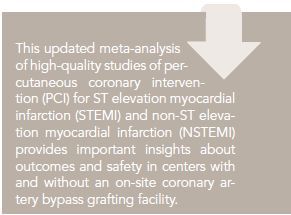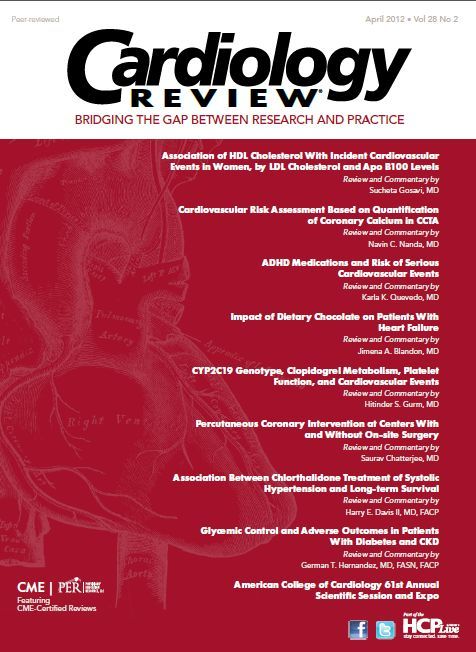Percutaneous Coronary Intervention at Centers With and Without On-site Surgery

Saurav Chatterjee, MD
Review

Singh M, Holmes DR Jr, Dehmer GJ, et al. Percutaneous coronary intervention at centers with and without on-site surgery: a meta-analysis. JAMA. 2011;306:2487-2494.
In their updated meta-analysis, Singh et al1 investigate and report on the outcomes of performing percutaneous coronary intervention (PCI) for both ST elevation myocardial infarction (STEMI) and non-ST elevation myocardial infarction (NSTEMI) in centers with and without an on-site coronary artery bypass grafting (CABG) facility. They have performed a systematic evaluation and synthesis of available data on the topic, with a resultant analysis that has greater inferential power than the individual observational studies available. The study provides important insights into a clinically relevant issue.
The American Heart Association/ American College of Cardiology (AHA/ACC) recommend class III status for performing PCI at institutions without on-site availability of CABG facilities. They have accorded a class IIb status for primary PCI in STEMI, provided other criteria are met. The concerns of the authors of the guidelines were mainly for a small but non-negligible group of patients who might experience a life-threatening complication that can be salvaged by immediate access to on-site cardiac surgery.2 Subsequent updates to the guidelines have not addressed the emerging body of data that has arisen since publication of the original recommendations.
Study Design
The methodology of Singh et al was sound, following standard protocols for a metaanalysis of observational studies to look at event rates. They followed the standardized
MOOSE guidelines3 for identifying and evaluating studies for inclusion. One author (Dr Singh) extracted the data. Inhospital mortality and the need for emergency CABG surgery were evaluated as outcomes individually for both STEMI and NSTEMI. Publication bias was assessed, with construction of funnel plots and adjustments with trim-and-fill method to estimate the effect of missing studies (estimated studies that did not get published due to severely unfavorable outcomes).4
The authors included 15 studies for the quantitative analysis, after identifying 1029 articles as relevant. For STEMI patients the pooled odds ratio (OR) for in-hospital mortality in patients undergoing primary PCI was derived from 124,074 patients. In-hospital mortality for patients at hospitals without on-site surgery was not different from hospitals having on-site surgery (OR, 0.96; 95% CI, 0.88-1.05) in both fixed-effects and random-effects models, with no observed heterogeneity (I2 = 0%). The funnel plot was narrow, and the estimated effects were consistent across various studies. The pooled OR for in-hospital mortality in patients undergoing nonprimary PCI was derived from 914,288 patients. Mortality was not significantly different for patients undergoing nonprimary PCI at facilities with and without on-site surgery (OR, 1.15; 95% CI, 0.93-1.41). Moderate heterogeneity (I2 = 46%) was identified in this group. After adjustment for publication bias, the mortality rate for nonprimary PCI was 25% higher at centers without on-site surgery compared with centers that had on-site surgery (OR, 1.25; 95% CI, 1.01-1.53; P = .04).
The incidence of emergency CABG for both primary and nonprimary PCI at centers without on-site surgery was low. The OR for emergency CABG surgery after primary or nonprimary PCI performed at sites without on-site surgery versus that at centers with on-site surgery was 0.53 (95% CI, 0.35-0.79) for primary PCI and was 1.21 (95% CI, 0.52-2.85) for nonprimary PCI in the random-effects model. Estimates of heterogeneity were low for these outcomes (I2 = 20% for primary PCI; I2 = 5% for nonprimary PCI). After adjustment for publication bias, the ORs were not substantially different. The authors performed a subset analysis of 11 studies in which the study period included no years earlier than 1999. The results of this analysis gave ORs very similar to those in the primary analysis: for patients with STEMI, the OR of death was 0.97 (95% CI, 0.88-1.06); for elective PCI, the OR for death was 1.15 (95% CI, 0.93-1.42); with STEMI the OR for emergency CABG surgery was 0.56 (95% CI, 0.37-0.84); and for elective PCI, the OR for emergency CABG surgery was 1.32 (95% CI, 0.49-3.59). The authors concluded that compared with centers having on-site surgery, PCIs performed at centers without on-site surgery were not associated with a higher incidence of in-hospital mortality or emergency bypass surgery.
References
1. Singh M, Holmes DR Jr, Dehmer GJ, et al. Percutaneous coronary intervention at centers with and without on-site surgery: a metaanalysis. JAMA. 2011;306(22):2487-2494.
2. Smith SC Jr, Feldman TE, Hirshfeld JW Jr, et al. American College of Cardiology/ American Heart Association Task Force on Practice Guidelines; ACC/AHA/SCAI Writing
Committee to Update 2001 Guidelines for Percutaneous Coronary Intervention. ACC/ AHA/SCAI 2005 guideline update for percutaneous coronary intervention: a report of the American College of Cardiology/American Heart Association Task Force on Practice Guidelines (ACC/AHA/SCAI Writing Committee to Update 2001 Guidelines for Percutaneous Coronary Intervention). Circulation. 2006;113:e166-e286.
3. Stroup DF, Berlin JA, Morton SC, et al. Meta-analysis of observational studies in epidemiology: a proposal for reporting. Meta-analysis Of Observational Studies
in Epidemiology (MOOSE) group. JAMA. 2000;283:2008-2012.
4. Sutton AJ, Duval SJ, Tweedie RL, Abrams KR, Jones DR. Empirical assessment of effect of publication bias on meta-analyses. Br Med J. 2000;320:1574-1577.
5. Zia MI, Wijeysundera HC, Tu JV, Lee DS, Ko DT. Percutaneous coronary intervention with vs without on-site cardiac surgery backup: a systematic review and meta-analysis [published online ahead of print May 5, 2011]. Can J Cardiol. 2011;27(5):664.e9-e16.
6. Elmariah S, Smith SC Jr, Fuster V. Late
medical versus interventional therapy for stable ST-segment elevation myocardial infarction. Nat Clin Pract Cardiovasc Med. 2008;5:42-52.
7. Kou V, Nassisi D. Unstable angina and non-ST-segment myocardial infarction: an evidence-based approach to management. Mt Sinai J Med. 2006;73:449-468.
8. Rogers WJ, Frederick PD, Stoehr E, et al. Trends in presenting characteristics and hospital mortality among patients with ST elevation and non-ST elevation myocardial infarction in the National Registry of Myocardial Infarction from 1990 to 2006. Am Heart J. 2008;156:1026-1034.
9. Dudek D, Rakowski T, Legutko J, et al. Efficacy and safety of percutaneous coronary interventions in patients with non-ST segment
elevation acute coronary syndrome in catheterisation laboratory without on-site surgical back-up. Kardiol Pol. 2003;58:356-365.
10. Ahmed I, Sutton AJ, Riley RD. Assessment of publication bias, selection bias, and unavailable data in meta-analyses using individual participant data: a database survey. BMJ. 2012;344:d7762. doi:10.1136/bmj. d7762.
11. Schwarzer G, Carpenter J, Rücker G. Empirical evaluation suggests Copas selection model preferable to trim-and-fill method for selection bias in meta-analysis. J Clin Epidemiol. 2010;63:282-288.
12. Kinlay S. The trials and tribulations of percutaneous coronary intervention in hospitals without on-site CABG surgery. JAMA.
2011;306:2507-2509
COMMENTARY
Safety and Outcomes of PCI at Centers With and Without On-site Surgery
Singh et al present us with a well-conducted meta-analysis of observational studies assessing outcomes with PCI at centers with and without an on-site CABG facility, showing no significant difference in major clinical end points from PCI being conducted at centers without CABG facilities. Their conclusions concur with a similar metaanalysis by other authors, arriving at virtually the same conclusion.5 However, a few interesting issues emerge.
The studies span a period of more than 20 years, a period that has witnessed massive advances in interventional techniques for management of procedural complications and stent usage for STEMI as well as pharmacological management of myocardial infarction (MI)—especially for late-presenting STEMI (>12 h)6 and NSTEMI.7 Hence, generally mortality after an MI has decreased.8 However, it is of concern that the subset analysis of recent studies by Singh et al did not reflect a lower rate of total events, or better event rates for PCI-only centers compared with older studies, raising the possibility of some risk of complications with PCI even at present, and raising doubts about the validity of the results.
The authors included only studies published in English and completely omitted unpublished studies and abstracts, which may have led to omission of relevant studies and data.9 Only 1 author was involved with the data extraction, raising a possibility of reviewer/selection bias.10 The authors performed various adjustments and approximations for their analysis, some of which are not universally accepted, especially for a robust conclusion.11
In summary, the authors attempt to question the class III recommendation for PCI at centers without surgical backup and the class IIb recommendation for STEMI patients. The adjusted analysis with a large sample size for non-primary PCI showed worse mortality (P = 0.04) for PCI-only centers, actually validating the current recommendations. In the absence of a randomized study with STEMI patients, and observing the Hippocratic oath of primum non/nil nocere, the class IIb recommendation also appears prudent. The meta-analysis does, however, make a strong case for further randomized data, and a continuous process of quality improvement, as noted in the accompanying editorial.12
About the Author
Saurav Chatterjee, MD, is a resident in internal medicine at Maimonides Medical Center in New York, NY. He graduated from Calcutta National Medical College with honors and was a resident in cardiology in Mercy Hospital, Kolkata, India, as well as trial coordinator of the CRESCENDO trial in Kolkata, India. He is the recipient of the 2011 American Association of Cardiologists
of Indian Origin Young Investigator Award for Interventional
Cardiology and Electrophysiology.
